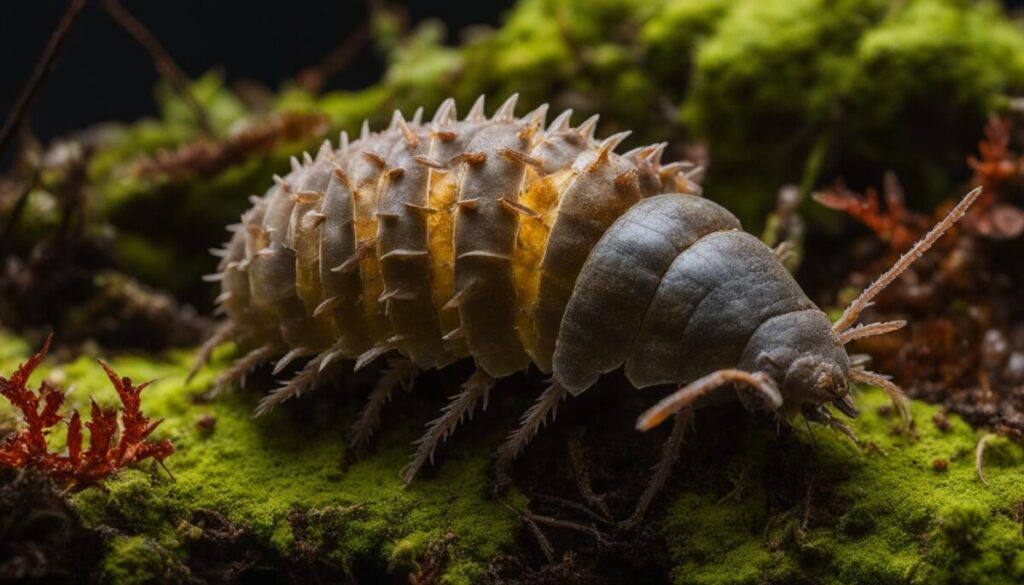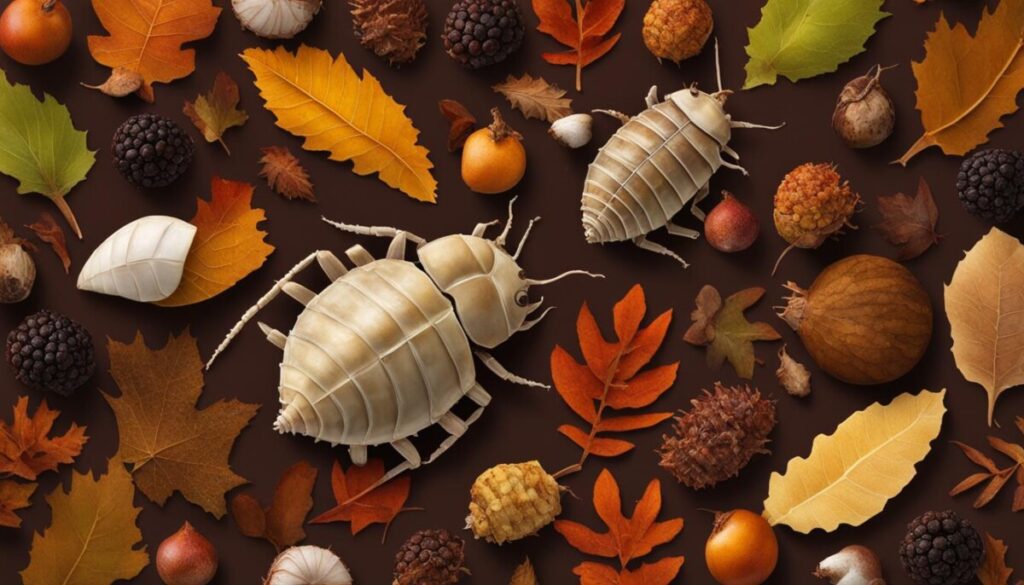Table of Contents
Welcome to our exploration of the fascinating world of isopod nutrition. As crustaceans, isopods have a diverse diet that plays a critical role in their overall health and survival. They are found in a wide range of environments, from ocean floors to coastal rock pools and even on land. Understanding what isopods eat is crucial to maintaining their well-being, whether you encounter them in the wild or keep them as pets. Let’s dive in and uncover the secrets of the isopod diet!
Key Takeaways:
- Isopods have varied diets depending on their environment.
- Understanding what isopods eat is key to their overall health and survival.
- Isopod food preferences can vary depending on taste and texture.
- Feeding habits of isopods are important to consider in captivity or in the wild.
- Terrestrial isopods, or woodlice, have specific food choices and adaptations for land-living.
Isopod Diet in the Wild: Exploring Natural Food Sources
Isopods are opportunistic feeders known for their diverse diet. In the wild, they rely on various food sources, including plants, fungi, algae, and animal matter. Their food preferences vary between species, and some are known to feed on decaying organic matter, while others are predators or herbivores.
One of the primary sources of food for isopods is decaying organic matter, such as dead leaves or wood. These crustaceans play a significant role in the breakdown of plant matter, which helps maintain essential soil nutrients. They also feed on fungi that grow on decaying organic matter, aiding in the decomposition process.
Another significant source of food for isopods is algae, which is abundant in many aquatic and terrestrial environments. Some isopods are known to graze on live algae, while others feed on dead or decaying algae. This food source is particularly important for aquatic isopods, which rely on it for survival.
| Isopod Food Sources | Food Preferences of Isopods |
|---|---|
| Plants | Some isopods are herbivores and graze on live plants, while others feed on decaying plant matter. |
| Fungi | Isopods aid in the decomposition process by feeding on fungi growing on decaying organic matter. |
| Algae | Isopods rely on algae as a significant food source, either by grazing on live algae or feeding on decaying algae. |
| Animal Matter | Some isopods are predators, while others feed on decaying animal matter. |
Isopods are also known to feed on animal matter, such as insects, snails, and rotifers. Some species are even predators, feeding on other small invertebrates. Terrestrial isopods, commonly known as woodlice, feed on a variety of plant and animal matter, depending on their species and habitat.
Overall, the diet of isopods in the wild is diverse and varied, with different species relying on different food sources. Their role in the ecosystem is crucial, as they contribute to the breakdown of organic matter and the maintenance of soil and aquatic health.

The Diet of Terrestrial Isopods: Adapting to Life on Land
Terrestrial isopods, commonly known as woodlice, have adapted to feeding on decaying plant matter, fungi, and other organic material found in their environment. These land-dwelling crustaceans play an important role in nutrient cycling, breaking down dead plant material and returning nutrients to the soil.
Woodlice have a unique digestive system that allows them to extract nutrients from the tough and fibrous material they consume. They have a crop, a stomach-like pouch where food is stored before being broken down by digestive enzymes. Woodlice also have a gizzard, a grinding chamber where food is ground up before entering the midgut where nutrients are absorbed.
While woodlice are primarily herbivorous, some species may also feed on small insects and other invertebrates. However, their feeding habits are largely dependent on their environment and the availability of food sources.
What Do Woodlice Eat?
Woodlice have a broad diet that includes:
- Decaying plant matter, such as leaves, bark, and wood
- Fungi and lichens
- Algae
- Moss
- Flowers and fruit
- Insects and other invertebrates (some species)
Woodlice are also known to exhibit selective feeding behavior, preferring certain food sources over others. In laboratory studies, some species have been observed to prefer diets rich in carbohydrates and low in protein, while others prefer high-protein diets.
Understanding the specific dietary needs and preferences of woodlice is important for their overall health and well-being. In captivity, providing a varied diet that mimics their natural food sources can help ensure their nutritional needs are met.

“Woodlice have adapted to feeding on decaying plant matter, fungi, and other organic material found in their environment.”
Feeding Habits of Isopods: Understanding Their Nutritional Needs
Isopods are omnivorous crustaceans with unique feeding habits that contribute to their role in ecosystems. They are scavengers and scavengers feed on a wide range of organisms, including dead plant material, detritus, fungi, and animal matter, such as carrion, insects, and other small invertebrates.
The feeding habits of isopods are influenced by both their physiological requirements and environmental factors. For instance, isopods require calcium for molting and building their exoskeleton, and they may seek out calcium-rich food sources, such as snail shells, to meet this need.
In captivity, it is essential to provide isopods with a varied diet that meets their nutritional needs. This can include fresh fruits, vegetables, and protein sources, such as fish food, shrimp pellets, or crushed eggshells. Ensuring that the isopods have access to a calcium source is also crucial for their overall health.
Feeding frequency can vary depending on the species and their life stage. Younger isopods require more frequent feedings, while adults may only require feeding once or twice a week. It is essential to monitor their feeding habits and adjust accordingly to ensure they are getting the necessary nutrition.
Overall, understanding the feeding habits of isopods is crucial for their well-being. Providing them with a varied diet that meets their nutritional needs can help ensure their longevity in captivity and their role in maintaining healthy ecosystems in the wild.
Isopod Food Preferences: Exploring Taste and Texture
Isopods may have a reputation for being scavengers that eat anything in their path, but they actually have interesting food preferences. Their feeding habits are influenced by a combination of taste and texture, making them selective eaters that avoid certain foods.
But what exactly do isopods prefer to eat? Studies have shown that they are attracted to foods with a high fat and protein content, such as fish and meat. They also enjoy fruits and vegetables, including carrots, apples, and bananas.
Texture is another factor that influences their food choices. Isopods prefer soft, moist foods over dry, hard ones. This is why they are often found eating decaying matter, as it is easier for them to break down and digest.
In addition to taste and texture, the time of day can impact their feeding behavior. Isopods are more active at night, meaning they may feed more frequently during these hours. This nocturnal activity is also why they are sometimes referred to as “pillbugs.”
It’s important to note that while isopods have specific food preferences, they are also opportunistic feeders that will eat whatever is available in their environment. In captivity, it’s important to provide them with a varied diet that meets their nutritional needs.
So, what can we take away from examining their food preferences? By understanding what isopods prefer to eat and why, we can better support their health and well-being. Whether in the wild or in our homes, providing a balanced diet that meets their nutritional needs and satisfies their taste and texture preferences is key to ensuring their survival.
Conclusion
In conclusion, understanding the diet of isopods is important for their survival and well-being. Isopods, also known as pillbugs or woodlice, have diverse feeding habits that contribute to their ecological role. By exploring the food sources of isopods in the wild, we can appreciate their unique food preferences and their place in the food chain.
Nutritional Needs and Feeding Habits
When considering the nutritional needs of isopods, it’s important to understand their feeding behavior. Isopods are omnivores and will consume a variety of plant and animal matter. In captivity, it’s important to provide a balanced diet that meets their nutritional requirements. Some common foods for isopods include fruits and vegetables, fish food, and decaying plant matter.
Taste and Texture Preferences
The taste and texture of food play a role in attracting isopods to particular food sources. Some isopods prefer soft or moist foods, while others prefer drier or harder options. Understanding these preferences can help optimize their diet and encourage feeding behavior.
The Importance of Adaptation
Terrestrial isopods, or woodlice, have adapted to life on land and have specific food choices that reflect this adaptation. They consume decaying wood and plants, as well as other organic matter found in soil. Understanding their unique feeding habits can help us appreciate their ecological role and support their well-being in captivity or in natural habitats.
In summary, understanding the complex and diverse diet of isopods is key to appreciating their ecological importance. By providing suitable food sources and keeping their nutritional needs in mind, we can ensure the health and happiness of these fascinating crustaceans.
FAQ
What do isopods eat?
Isopods have a varied diet, which typically includes decaying plant matter, fruits, vegetables, and even some animal matter. They are detritivores, meaning they feed on dead organic material.
What is the diet of isopods in the wild?
In the wild, isopods feed on a wide range of food sources, including leaf litter, rotting wood, algae, fungi, and decomposing plant material. They play an important role in breaking down organic matter and recycling nutrients within ecosystems.
What do terrestrial isopods, like woodlice, eat?
Terrestrial isopods, such as woodlice, primarily feed on decaying plant matter, dead leaves, and fungi. They are also known to graze on living plants, although they generally prefer dead or decaying vegetation.
What are the feeding habits of isopods?
Isopods are scavengers and foragers, constantly searching for food. They have specialized mouthparts for chewing and grinding their food. They are generally nocturnal and prefer to feed in moist environments.
Do isopods have any specific nutritional needs?
Isopods require a balanced diet to thrive. This includes a mixture of carbohydrates, proteins, fats, and vitamins. In captivity, it’s important to provide a well-rounded diet that mimics their natural food sources to ensure their nutritional needs are met.
What are the food preferences of isopods?
Isopods are attracted to foods with a high moisture content, as they aid in their digestion. They also have preferences for certain flavors and textures. Some isopods may show a preference for sweeter or more acidic foods, while others prefer softer or more fibrous options.

Pingback: Diets of Isopods: Understanding What These Crustaceans Eat - Wiggle And Waste
Pingback: 10 Facts about Isopods: Interesting Information about These Crustaceans - Wiggle And Waste
Pingback: Discover Nature's Intrigue: The Different Types of Isopods